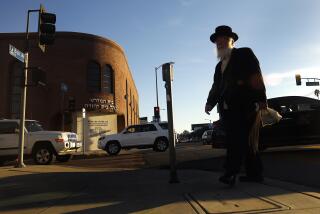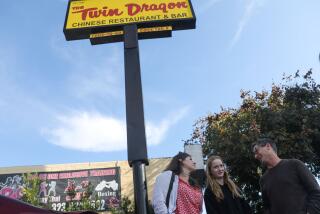Ancient Ritual : Children Get a Taste of the Past
- Share via
Destined for ritual slaughter, two chickens served a higher purpose Monday in an ancient atonement ceremony for 500 students at the Hebrew Academy-Lubavitch in Westminster.
The little known, 700-year-old ritual of kapparot comes on the eve of Yom Kippur, when life is said to hang in the balance.
“We consider where the chicken ends up could be where we end up,” said Chassidic Rabbi Gershon Schusterman, director of the Jewish day school. “Thank God we can be spared and the chicken takes our place, so to speak.”
One of the more colorful and controversial of Chassidic customs, kapparot “is one part of folk religion which has been rejected by many, many Jews,” said Rabbi Lawrence Goldmark, past president of the Orange County Board of Rabbis, and a leader of the reform congregation Temple Beth Ohr in La Mirada.
“Our feeling is there came into Judaism certain customs that were rooted in superstition and/or folk religion which were not advocated by the rabbis but which were nonetheless accepted and promulgated by the lay people. And one of them is this tradition, if you will, of taking a chicken and slaughtering it in substitution.”
Growing Numbers
The majority of the county’s 75,000 Jews belong to reform, conservative and modern orthodox congregations and do not observe the custom, he said.
“I would say the vast majority of Jews do not observe the Sabbath either,” countered Schusterman.
But the county’s growing orthodox followers--estimated at about 1,000--practice the ritual either at kosher chicken markets in Los Angeles or at home with live chickens, Schusterman said.
Aware that the practice strikes a bizarre note for others, Schusterman called kapparot an ancient tradition--and a small one of 40 customs along with 40 additional laws and 613 commandments that make up the mosaic of his faith.
With the help of his son, Achiezer, 10, the rabbi performed kapparot for his 3-year-old twins, Kushi and Pzippy, at school. Reading from his prayer book, he circled a rooster over the boy while Achiezer circled a flapping hen over the girl, as tradition calls for.
The children played with feathers as he read in Hebrew: “This is my exchange, this is my substitute, this is my expiation. This chicken shall go to its death, and I shall proceed to a good long life and peace.”
Monday, the ceremony was repeated for each student, from nursery through high school, he said. While its significance is beyond the grasp of most youngsters, “it gets their attention and leaves an impression,” he said.
According to custom, the chickens were to be returned to a kosher market in Los Angeles for slaughter and given to needy Jews, Schusterman said.
Instead of chickens, some people use goldfish, he said. Animal sacrifice is not allowed under modern Jewish law, and thus animals designated for sacrifice under ancient law--such as doves, pigeons or goats--cannot be used, he said.
Most practicing Jews will spend the holy day Wednesday fasting and praying for forgiveness on a “one-on-one” basis, Goldmark said.
Most are unaware of kapparot, which was brought along with other orthodox customs to Orange County in 1976 when Chassidic rabbis opened the academy as part of their mission to “bring Judaism back to Jews.” Since then Chabad congregations have sprung up in Irvine, Laguna Beach, Anaheim, Yorba Linda and Huntington Beach.
The Chassidic movement began in the 18th Century as a mystical and ecstatic Jewish religious movement but later turned conservative. Chabad Chassidism, also known as Lubavitcher Chassidism, is headquartered in Brooklyn, N.Y. and led by a dynasty of rebbes.
More to Read
Sign up for Essential California
The most important California stories and recommendations in your inbox every morning.
You may occasionally receive promotional content from the Los Angeles Times.












